Multi-label graph analysis and computations using GraphX
- 1. Qingbo Hu1, Qiang Zhu2 Multi-label Graph Analysis and Computations Using GraphX 1. Qingbo Hu is a Senior Business Analytics Associate at LinkedIn 2. Qiang Zhu currently works for Airbnb. The work introduced in this talk was done when he was a manager at LinkedIn
- 2. Overview • Background • Motivation and Goal • Constructing Multi-label Graphs • Multi-label PageRank • Experiments • Conclusion
- 3. Background • Network Analysis – Applications: Telecommunication Network Bioinformatics Social Network
- 4. Background • Network Analysis (cont’d) – Features of interest: • (In/Out) degrees • # triangles • (Strongly) connected component • Etc. – Graph-based algorithms • PageRank [1] • Label Propagation [2] • HITS [3] • etc.
- 5. Motivation and Goal • Homogeneous Network – Single type of nodes and single type of edges – Example: Citation networks: author, citation Friendship networks: user, friendship – Not enough to depict complicated real-life networks – Supported by GraphX
- 6. Motivation and Goal • Heterogeneous Networks – Nodes of multiple types and edges of multiple types – Example: Social Network User Activity Graph: user, reply, comment, like etc. LinkedIn Economic Graph: member, company, employment, connection etc. – Better resembles real-life networks – Can be represented by labels on nodes and edges – Not directly supported by GraphX Multi-label graphs
- 7. Motivation and Goal • Social activity graph on LinkedIn – Nodes: – Edges: Member Company 1 Company 2 Member 1 Member 2
- 8. Motivation and Goal • Social activity graph on LinkedIn (cont’d) – Questions: • How many times a member likes/comments/shares other people’s posts? • Who has the highest PageRank score in each company with respect to like/comment/share behavior? • Etc. Network features with respect to labels Graph-based algorithm on label level Spark + GraphX • No direct support • Multiple subgraphs for different labels => waste of time and resource • A unified solution is preferred
- 9. Motivation and Goal • Solutions based on GraphX to provide Multi-label graph analysis • Short-term goals – Construction of multi-label graphs – Efficient computation of PageRank score with respect to all labels • Long-term goals – A general API library supports the following additional operations: • Multi-label Graph transformation • Network features on the label level – Implementations for additional common graph-based algorithms • Label Propagation • HITS • Etc.
- 10. Constructing Multi-label Graphs • Node – (ID, labels, nodeFeatures) • ID: a unique long associated with the node • labels: A set contains node labels • nodeFeatures: Other node dependent features • Edge – (fromID, toID, label, edgeFeatures) • fromID: the ID of the edge’s source node • toID: the ID of the edge’s target node • label: A label associated with the edge • edgeFeatures: Other edge dependent features
- 11. Constructing Multi-label Graphs • Node labels vs. edge labels – Edge label is more important in many network features • PageRank score, (in/out) degrees, strongly connected component etc. – Node labels are used to filter nodes – Why? • Edge labels are usually used to form meaningful subgraphs – Random walk follows edges, degrees are respect to edge labels etc. • Node labels can be absorbed in edges if necessary – a graph transform operation Top influencers for each company Top influencers within each company
- 12. Constructing Multi-label Graphs • Methods to create a multi-label graph – NodeRDDs + EdgeRDDs – EdgeRDDs (no node labels) – Load directly from file: A list of edges: (source, target, label) A list of nodes: (ID, label_1, label_2, …, label_n) => optional – Transformation from other multi-label graphs
- 13. Multi-label PageRank • PageRank – Developed by Larry Page and Sergey Brin – Used to rank web pages – Important pages are always linked by other important pages – Iteratively updating scores until they converge – The obtained score: PageRank score
- 14. Multi-label PageRank • PageRank (cont’d) – For an edge (pj, pi), the edge weight is defined by 1/ ,where is the out degree of pj – Initial score for every node: 1.0 or 1.0 / N – Later iteration: – In order to ensure convergence, we allow a small probability to be “teleported” to any node (reset probability) A B C 0.5 0.5 or
- 15. Multi-label PageRank • PageRank (cont’d) – Power iteration through matrix manipulation • Vector: scores • Matrix: transitional matrix • Each iteration: vector * matrix • Waste resource if the transitional matrix is sparse – Directly simulate the computation process • Easier for parallel implementation • Pregel
- 16. Multi-label PageRank • Pregel – A general programming interface for graph-based algorithms – Proposed by Google – Supported by GraphX – Iterative algorithm until convergence conditions are met – For each iteration, we need to consider: 1. How to construct the message passed along edges? => Message sender 2. How to combine received messages on a node? => Message combiner 3. How to use the combined message to update the info on a node? => Vertex Program
- 17. Multi-label PageRank • Construct a graph used for PageRank computation – PageRankNodeType: Map[Int, (Double, Double)] • label: the label associated with the PageRank score • score: the value of PageRank score • score_diff: the difference of scores between two iterations – PageRankEdgeType: [Int, Double] • label: the label associated with the message • weight: the transitional probability on the edge – PageRankMsgType: Map[Int, Double] • label: the label associated with the message • message: a double valued score used to update PageRank score Why do we use Map[Int, Double] instead of (Int, Double)?
- 18. Multi-label PageRank • Message Sender def sendMessage(edge: EdgeTriplet[PageRankNodeType, (Short, Double)]) = { // Label on the current edge val label = edge.attr._1 if (edge.srcAttr(label)._2 > tol) { val msg = mutable.Map[Short, Double]() msg += label -> edge.srcAttr(label)._2 * edge.attr._2 Iterator((edge.dstId, msg)) } else { Iterator.empty } } Create the message to be passed on the edge as a map
- 19. Multi-label PageRank • Message Combiner def messageCombiner(a : PageRankMsgType, b : PageRankMsgType) : PageRankMsgType = { a ++ b.map{ case (k,v) => k -> (v + a.getOrElse(k, 0.0))} } Combine received maps into a single one
- 20. Multi-label PageRank • Vertex Program def vertexProgram(id: VertexId, attr: PageRankNodeType, msgSum: PageRankMsgType): PageRankNodeType = { … attr.map{ case (label, (oldPR, lastDelta)) => { val newPR = oldPR + (1.0 - resetProb) * msgSum.getOrElse(label, 0.0) val newDelta = newPR - oldPR (label -> (newPR, newDelta)) } } } Using combined message to update PageRank score
- 21. Experiments • LinkedIn social activity graph – Sampled from all social activities in Nov. 2016 – Nodes: ~2 million users – Node labels: companies – Edge labels: • Like • Share • Comment – Edges: ~76 million – Rest probability: 0.15 – Convergence granularity: 1e-3 – Number of executor: 50 – Executor cores: 3 – Executor Memory: 12G
- 22. Experiments • Convergence around 100 iterations • Total running time: 30~40 mins • A case study for LinkedIn: Jeff Weiner Daniel Roth Greg Call Jeff Weiner Kathy Caprino Isabelle Roughol Jeff Weiner Isabelle Roughol Akshay Kothari
- 23. Experiments • Further discussions and lessons learned – For edge type in multi-label graphs (fromID, toID, label, edgeFeatures) => (fromID, toID, Map(label, edgeFeatures)) • Reduce duplication and save space • Slower process time – Standard Pregel interface in GraphX • Although data from the last iteration is unpersisted, DAG will keep grow • Might cause out of memory error • Pregel interface with (local) checkpoint to cut off the DAG after several iteration – Test on larger data sets and various data sources
- 24. Conclusion • Network Analysis – Graph features – Graph-based algorithms • Homogeneous vs. Heterogeneous Networks • Multi-label Graphs – Node & Node labels – Edge & Edge labels – Constructing a multi-label graph • Multi-label PageRank – PageRank – Pregel-based implementation • Experiments
- 25. References [1] Page, Lawrence, et al. The PageRank citation ranking: Bringing order to the web. Stanford InfoLab, 1999. [2] Zhu, Xiaojin, and Zoubin Ghahramani. "Learning from labeled and unlabeled data with label propagation." (2002): 1. [3] Kleinberg, Jon M. "Hubs, authorities, and communities." ACM computing surveys (CSUR) 31.4es (1999): 5.
- 26. Thank You! Qingbo Hu (qihu@linkedin.com)
Editor's Notes
- #23: Daniel Roth: Editor in Chief Greg Call: Head of Veterans Program, works for Amazon now Kathy Caprino: LinkedIn Publishing Member Advisory Board Isabelle Roughol: Senior Editor Akshay Kothari: Head of LinkedIn India

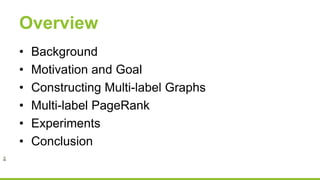
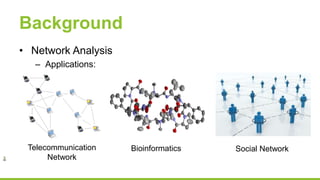
![Background
• Network Analysis (cont’d)
– Features of interest:
• (In/Out) degrees
• # triangles
• (Strongly) connected component
• Etc.
– Graph-based algorithms
• PageRank [1]
• Label Propagation [2]
• HITS [3]
• etc.](https://image.slidesharecdn.com/multi-labelgraphanalysisandcomputationsusinggraphx-170612231906/85/Multi-label-graph-analysis-and-computations-using-GraphX-4-320.jpg)
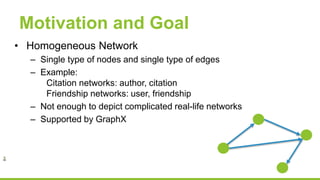
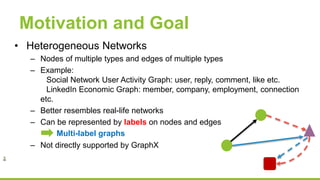
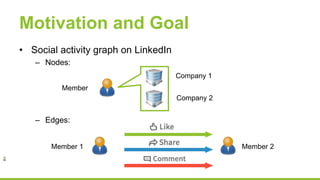
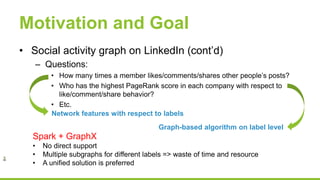
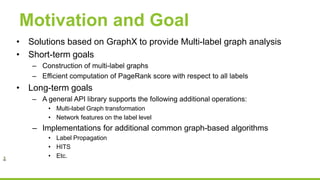
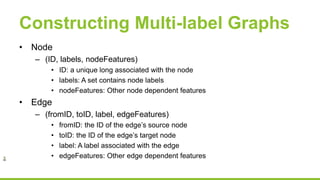
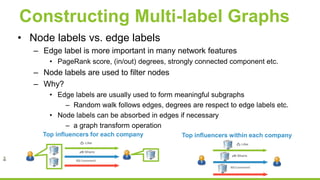
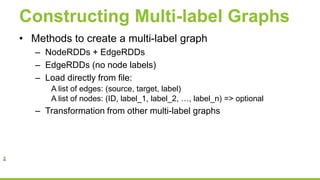
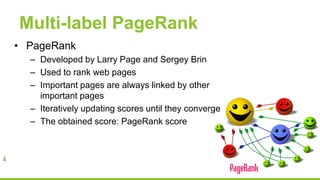
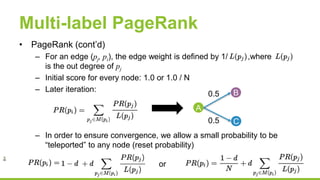
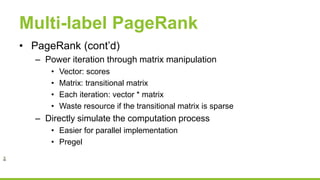

![Multi-label PageRank
• Construct a graph used for PageRank computation
– PageRankNodeType: Map[Int, (Double, Double)]
• label: the label associated with the PageRank score
• score: the value of PageRank score
• score_diff: the difference of scores between two iterations
– PageRankEdgeType: [Int, Double]
• label: the label associated with the message
• weight: the transitional probability on the edge
– PageRankMsgType: Map[Int, Double]
• label: the label associated with the message
• message: a double valued score used to update PageRank score
Why do we use Map[Int, Double] instead of (Int, Double)?](https://image.slidesharecdn.com/multi-labelgraphanalysisandcomputationsusinggraphx-170612231906/85/Multi-label-graph-analysis-and-computations-using-GraphX-17-320.jpg)
![Multi-label PageRank
• Message Sender
def sendMessage(edge: EdgeTriplet[PageRankNodeType, (Short, Double)]) = {
// Label on the current edge
val label = edge.attr._1
if (edge.srcAttr(label)._2 > tol) {
val msg = mutable.Map[Short, Double]()
msg += label -> edge.srcAttr(label)._2 * edge.attr._2
Iterator((edge.dstId, msg))
}
else {
Iterator.empty
}
}
Create the message to be passed
on the edge as a map](https://image.slidesharecdn.com/multi-labelgraphanalysisandcomputationsusinggraphx-170612231906/85/Multi-label-graph-analysis-and-computations-using-GraphX-18-320.jpg)
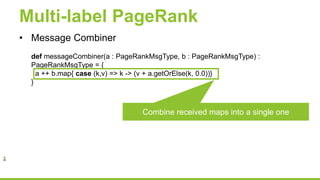


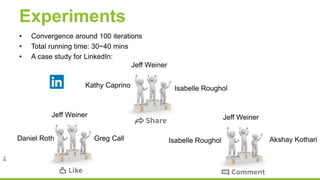


![References
[1] Page, Lawrence, et al. The PageRank citation ranking: Bringing order to the web. Stanford InfoLab,
1999.
[2] Zhu, Xiaojin, and Zoubin Ghahramani. "Learning from labeled and unlabeled data with label
propagation." (2002): 1.
[3] Kleinberg, Jon M. "Hubs, authorities, and communities." ACM computing surveys (CSUR) 31.4es
(1999): 5.](https://image.slidesharecdn.com/multi-labelgraphanalysisandcomputationsusinggraphx-170612231906/85/Multi-label-graph-analysis-and-computations-using-GraphX-25-320.jpg)
